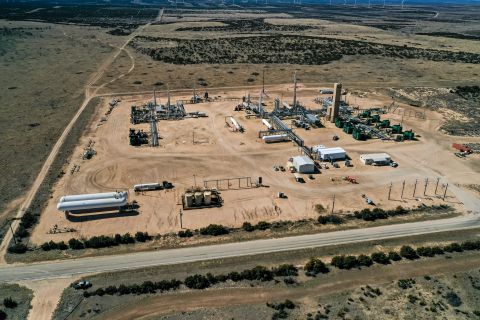
The tank farm at Devon Canada's Jackfish plant in Alberta. (Source: Devon Energy Corp.)
Devon Canada is one of the more efficient producers in the Alberta oil sands. Having led the charge on lower costs of production and capital, the company now faces the frustration of having to wait on the several pipeline projects to get its molecules either to market in the U.S. or to tidewater in Canada for export to Asia.
“The clouds are starting to part,” said Rob Dutton, senior vice president of Canadian operations for Devon Energy Corp. (NYSE: DVN). “We have to be pragmatic and realistic, but I am quite optimistic; actually more today than I was a year ago. We have seen support on the Trans Mountain, and are seeing some regulatory support on Keystone XL. There has been a lot of activity [in midstream development to get Alberta production to market] at all levels of government and among the pipeline companies. They all understand the challenges.”
 To the extent it can, Devon Canada has taken a role within the framework of operators and regulators. Call that enlightened self-interest. Since its first development at Jackfish came into service in 2007, the company has expanded to a second and third complex. Production for 2016 (the latest full-year recorded) was 134,000 barrels of oil equivalent per day (boe/d), 98% of which was liquids. That represented 22% of all of Devon’s total production across the corporation.
To the extent it can, Devon Canada has taken a role within the framework of operators and regulators. Call that enlightened self-interest. Since its first development at Jackfish came into service in 2007, the company has expanded to a second and third complex. Production for 2016 (the latest full-year recorded) was 134,000 barrels of oil equivalent per day (boe/d), 98% of which was liquids. That represented 22% of all of Devon’s total production across the corporation.
Reserves are similar: the 504 million barrels of oil equivalent—99% liquids—represents 24% of all Devon corporate reserves. In light of that, the company invested about $300 million in the play in 2017. Devon has 100% working interest in all Jackfish properties. The company also has a 50% interest in the undeveloped Pike leases located adjacent to its Jackfish complex.
That said, there are no expansion plans for 2018 as the company awaits midstream growth.
“We do plan to maximize current assets,” Dutton told Hart Energy. “And we do have excellent opportunities for growth. But we are not prepared to make the next leap in the short term.”
 Company sources say they are hopeful that next leap will come sooner rather than later. There is pull as well as push in this equation.
Company sources say they are hopeful that next leap will come sooner rather than later. There is pull as well as push in this equation.
“There are buyers that do help by indicating that they need Alberta crudes,” said Shonda Day, director of energy marketing for Devon in Canada. “There are refineries in the Midwestern U.S. that support greater access to Alberta crudes. There is consistent interest into the U.S. Gulf. We have also had meetings with refiners in Asia who want to understand their options and transit times. They are interested in diversity of supply, and they see Canada as a stable and reliable source, if we can get to market.”
While the long-term prospects remain tantalizing, the near-term vexation grows and differentials are already starting to grow.
“The overall competitiveness of Canadian barrels is under pressure,” Dutton said. Transportation has not made it any easier.
“We do need tangible progress. There has been some frustration over lack of access,” he acknowledged. “Then again, this is not new. We have had the issue hanging over us for so long in some ways it has become part of the furniture. It’s not just getting to the U.S. but even getting to tidewater in our own country has been difficult.”
Treading a fine diplomatic line, Dutton added, “With any new line or expansion, an appropriate level of scrutiny is necessary. It seems, however, that the process has been taken advantage of to frustrate any progress anywhere. A minority of interests has been able to frustrate the majority interest in what is good for the country, but that is starting to change. For example, Trans Mountain has operated for five decades, and has been reliable and safe.”
As was the case for the Bakken and other inland plays in the U.S., rail remains an alternative as Alberta producers await midstream growth.
“Rail has played a pretty important role as a swing option for several years,” Dutton said. “There will be increased reliance on rail in the near term. That said, winter is more difficult for rail. We are already seeing differentials get wider not because of the availability of diluent, but the availability of pipe space.”
Recommended Reading
Midstream M&A Adjusts After E&Ps’ Rampant Permian Consolidation
2024-10-18 - Scott Brown, CEO of the Midland Basin’s Canes Midstream, said he believes the Permian Basin still has plenty of runway for growth and development.
Post Oak-backed Quantent Closes Haynesville Deal in North Louisiana
2024-09-09 - Quantent Energy Partners’ initial Haynesville Shale acquisition comes as Post Oak Energy Capital closes an equity commitment for the E&P.
Analyst: Is Jerry Jones Making a Run to Take Comstock Private?
2024-09-20 - After buying more than 13.4 million Comstock shares in August, analysts wonder if Dallas Cowboys owner Jerry Jones might split the tackles and run downhill toward a go-private buyout of the Haynesville Shale gas producer.
Aethon, Murphy Refinance Debt as Fed Slashes Interest Rates
2024-09-20 - The E&Ps expect to issue new notes toward redeeming a combined $1.6 billion of existing debt, while the debt-pricing guide—the Fed funds rate—was cut on Sept. 18 from 5.5% to 5%.
Dividends Declared Sept.16 through Sept. 26
2024-09-27 - Here is a compilation of dividends declared from select upstream, midstream and service and supply companies.
Comments
Add new comment
This conversation is moderated according to Hart Energy community rules. Please read the rules before joining the discussion. If you’re experiencing any technical problems, please contact our customer care team.






